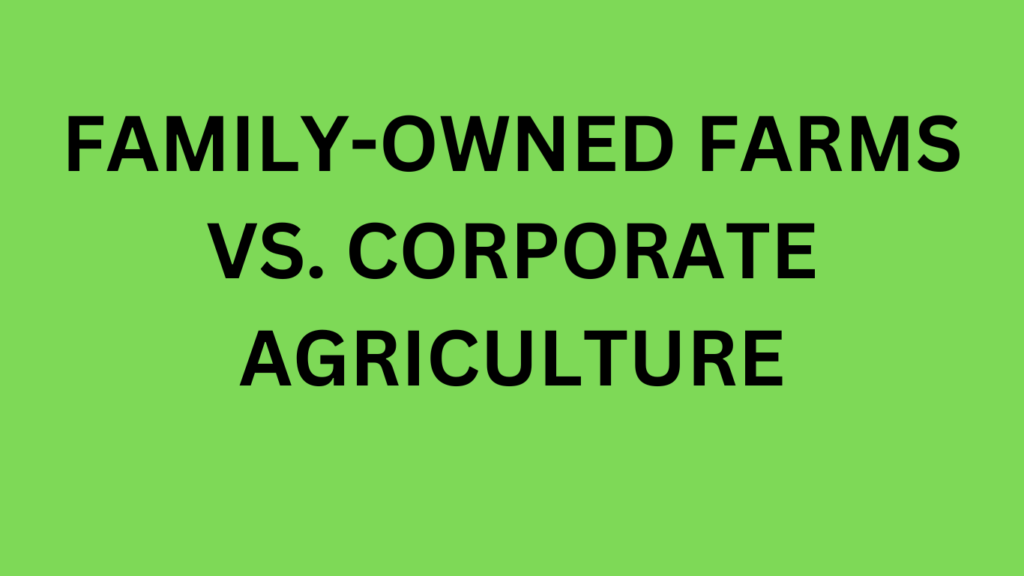Introduction
Agriculture plays a crucial role in global food production, and the structure of farms significantly impacts economies, communities, and food security. Two primary types of farming operations exist: family-owned farms and corporate agriculture. Each has distinct characteristics, advantages, and challenges. This document explores the differences between these two farming models, examining their economic impact, sustainability, efficiency, and role in food production.
1. Definition and Characteristics
Family-Owned Farms
- Typically owned and operated by individuals or families across generations.
- Often smaller in scale, with land passed down through family lineage.
- May focus on diverse crops or livestock rather than large-scale monoculture.
- Decisions are made by family members rather than external shareholders.
Corporate Agriculture
- Large-scale farming operations owned by corporations or agribusiness entities.
- Utilizes industrial farming techniques and large amounts of land.
- Often specializes in a single type of crop or livestock (monoculture farming).
- Decision-making is influenced by investors, stakeholders, and market demands.
2. Economic Impact
Family-Owned Farms
- Contribute to rural economies and local communities.
- Generate income for families, supporting regional businesses and markets.
- Limited access to large-scale funding and technology compared to corporations.
Corporate Agriculture
- Major contributor to national and global food supply chains.
- Increases efficiency and productivity through mechanization and economies of scale.
- Can dominate markets, potentially reducing competition and impacting small farmers.
3. Sustainability and Environmental Considerations
Family-Owned Farms
- Often practice sustainable farming techniques such as crop rotation and organic farming.
- Focus on soil conservation and biodiversity preservation.
- Limited financial resources may make adoption of eco-friendly technology difficult.
Corporate Agriculture
- High production efficiency but often criticized for environmental concerns like deforestation and excessive pesticide use.
- Large carbon footprint due to industrial-scale operations.
- Investments in precision agriculture and genetic modifications to increase sustainability.
4. Efficiency and Productivity
Family-Owned Farms
- Tend to have diversified production, making them resilient to market fluctuations.
- Lower yields compared to corporate farms due to limited mechanization.
- Stronger focus on quality and organic products over mass production.
Corporate Agriculture
- High output levels due to mechanized equipment and advanced technology.
- Use of artificial intelligence (AI) and automation for monitoring and optimizing production.
- Greater vulnerability to global market shifts due to reliance on large-scale distribution.
5. Labor and Workforce Differences
Family-Owned Farms
- Primarily employ family members with occasional seasonal workers.
- Labor-intensive, requiring manual effort and traditional farming techniques.
- Provide stable livelihoods for rural communities.
Corporate Agriculture
- Employ large workforces, including migrant and seasonal laborers.
- High reliance on mechanized operations, reducing the need for manual labor.
- Labor disputes and ethical concerns, particularly regarding fair wages and working conditions.
6. Food Supply Chain and Market Influence
Family-Owned Farms
- Sell products locally, supporting farmers’ markets and community-supported agriculture (CSA) programs.
- Limited access to large distribution networks compared to corporate farms.
- Vulnerable to price fluctuations and competition from industrial farms.
Corporate Agriculture
- Control significant portions of food supply chains, distributing products globally.
- Strong market influence, affecting prices, policies, and trade agreements.
- Benefits from government subsidies and large-scale production capabilities.
7. Role in Food Security
Family-Owned Farms
- Ensure regional food security by providing fresh, local produce.
- Less susceptible to global trade disruptions but more vulnerable to natural disasters and climate variability.
Corporate Agriculture
- Supplies food at scale, meeting global demand efficiently.
- Relies on global trade networks, which can be disrupted by economic and political factors.
- Faces criticism for prioritizing profit over food accessibility and nutritional quality.
8. Challenges and Future Outlook
Family-Owned Farms
- Struggle with financial sustainability due to rising land costs and low market prices.
- Face generational transition issues, with fewer young people taking up farming.
- Need government support and technology adoption to remain competitive.
Corporate Agriculture
- Faces increasing pressure to adopt sustainable and ethical practices.
- Encounters resistance from consumers advocating for organic and locally sourced food.
- Expected to integrate more AI, automation, and climate-resilient techniques in the future.
Conclusion
Both family-owned farms and corporate agriculture are essential for global food production, each with its unique strengths and challenges. Family farms preserve traditional farming methods, promote local economies, and focus on sustainability, while corporate agriculture ensures large-scale food supply and efficiency. A balanced approach that integrates the best practices of both systems could create a sustainable and resilient agricultural future.



